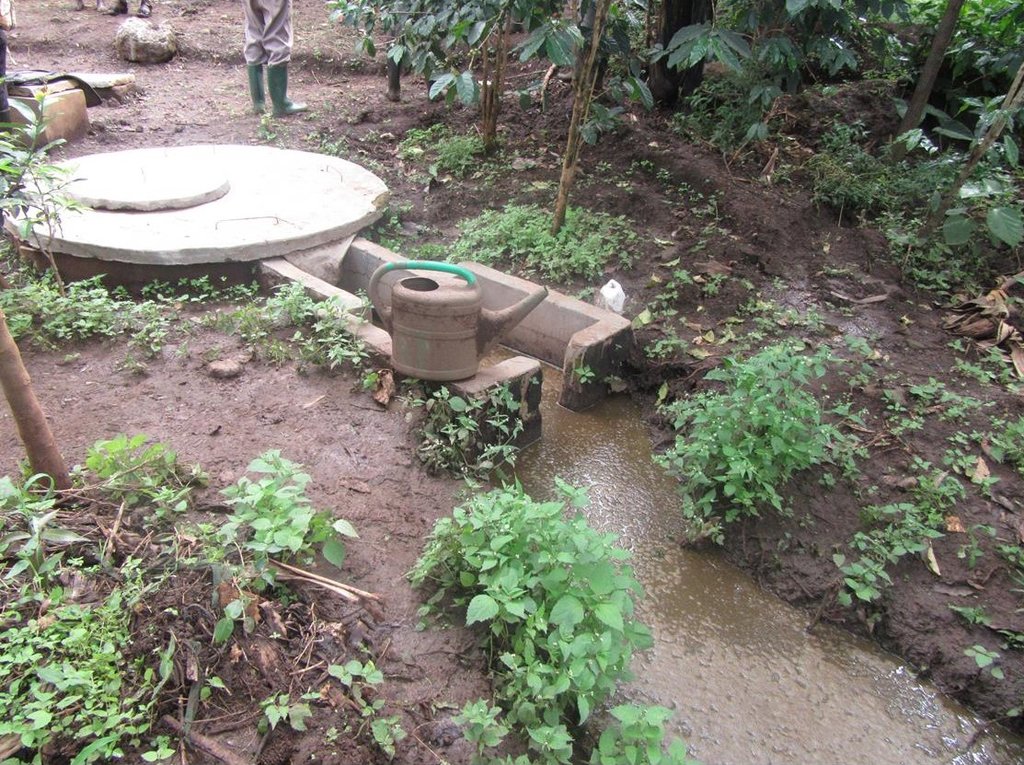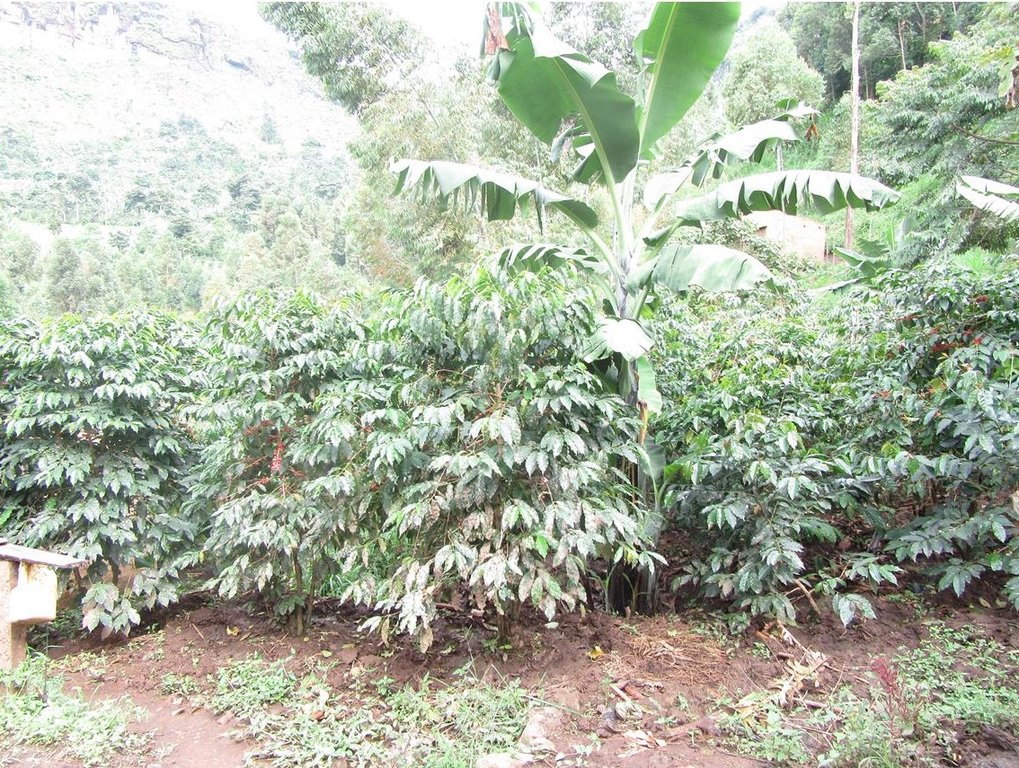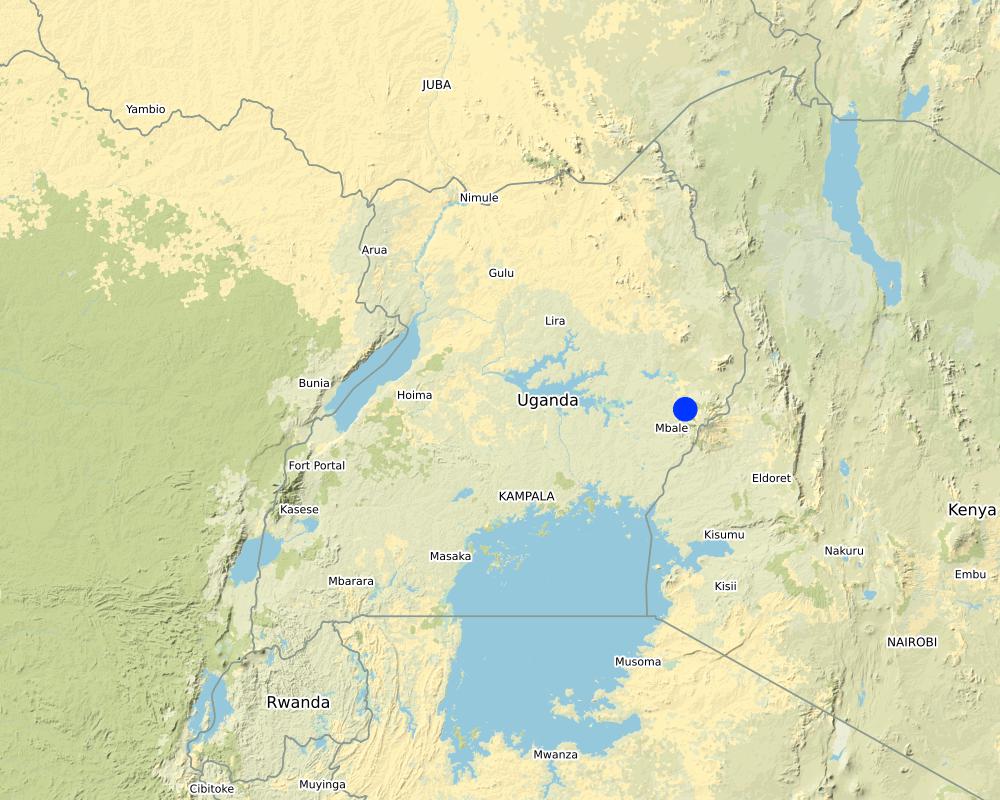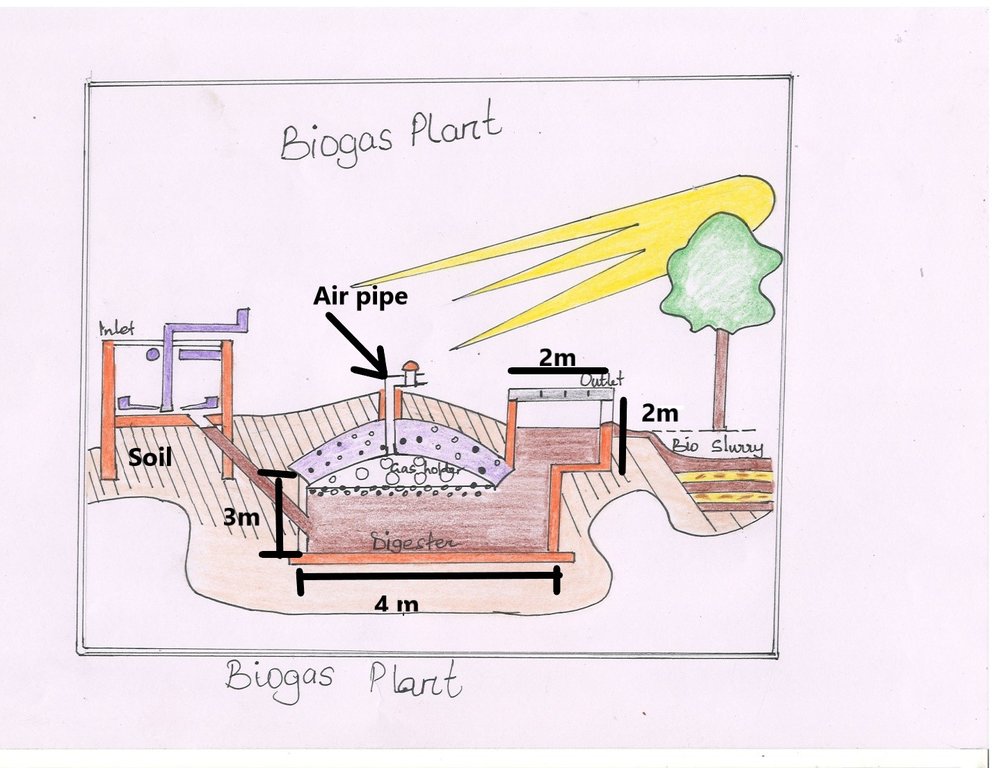Domestic Biogas Plant for fuel and organic fertilizer [乌干达]
- 创建:
- 更新:
- 编制者: JOSELINE KASHAGAMA
- 编辑者: Kamugisha Rick Nelson
- 审查者: Nicole Harari, Udo Höggel, Donia Mühlematter
Bayogasi
technologies_3371 - 乌干达
查看章节
全部展开 全部收起1. 一般信息
1.2 参与该技术评估和文件编制的资源人员和机构的联系方式
关键资源人
土地使用者:
Wodonya Patrick
+256 786 189490
Bulambuli District Eastern Uganda
乌干达
有助于对技术进行记录/评估的项目名称(如相关)
Scaling-up SLM practices by smallholder farmers (IFAD)有助于对技术进行记录/评估的机构名称(如相关)
National Agricultural Research Organisation (NARO) - 乌干达1.3 关于使用通过WOCAT记录的数据的条件
(现场)数据是什么时候汇编的?:
19/10/2017
编制者和关键资源人员接受有关使用通过WOCAT记录数据的条件。:
是
1.4 所述技术的可持续性声明
这里所描述的技术在土地退化方面是否存在问题,导致无法被认为是一种可持续的土地管理技术?:
否
注释:
Biogas protects the environment through reduced tree cutting and emission of harmful gases and the bi- product removed from the digester is used as organic fertilizer that boosts crop production.
2. SLM技术的说明
2.1 技术简介
技术定义:
Domestic biogas plant converts livestock manure into biogas and organic fertilizer. The technique uses cow dung to produce methane gas for lighting and heating.
2.2 技术的详细说明
说明:
Domestic biogas plants convert livestock manure into biogas and bio-slurry, a form of organic fertilizer (fermented manure). Biogas is a renewable energy or gas produced by the breakdown of organic matter in the absence of oxygen. Most people in Uganda, especially in rural areas, don’t have access to electricity and mostly rely on firewood and charcoal (mostly in urban areas). This has led to depletion of forests since these forests are the main supply of wood fuel. The domestic biogas technique uses fresh cow dung to produce methane gas for lighting and heating.
This technology is viable for smallholder farmers with livestock that are capable of producing 25 kg of fresh dung per day, typically about five indigenous cows. This makes the technology suitable for smallholders in developing countries. Fresh cow dung is collected and mixed with water at a ratio of 1:1, depending on the thickness of the dung, to produce a free-flowing mixture. The mixture is poured into the digester where microbes break it down under an oxygen-free environment and in the process release methane gas which is harvested in a cylinder and piped straight into the home for lighting and/ or heating.
Dimensions for the Digester (4m in diameter and 3 m in depth). Overflow tank/ Outlet is 2 meters by 2 meters. Materials used in the construction of the plant include sand, cement, bricks, iron rods, gravel and water. Biogas stove, lamp and its appliances and gas controller or pressure gauge are connected after the construction of the biogas plant which can be purchased from specified outlets on the urban markets.
Production and use of biogas protects the environment through reduced tree cutting and emission of harmful greenhouse gases (GHG). It also eases the workload of rural women and children by providing a safe and cheap source of fuel since it reduces the risk encountered by children and women looking for firewood and spares their time that would otherwise be spent in the process. The bi-product (bio-slurry) removed from the digester at the end of the process is used as organic fertilizer which boosts crop productivity and is a highly nutritious feed supplement for animals.
The technology has safety issues especially on the side of children when it comes to the flammable gas.
2.3 技术照片
2.4 技术视频
注释、简短说明:
The video couldn't be captured since the largest part of the biogas plant is below the ground and the system was constructed long ago before the documentation process.
2.5 已应用该技术的、本评估所涵盖的国家/地区/地点
国家:
乌干达
区域/州/省:
Eastern Uganda
有关地点的进一步说明:
Sisiyi Sub county, Gibuzale Parish, Bulabuli District
注释:
1.2899 , 34.3551
Map
×2.6 实施日期
注明实施年份:
2016
2.7 技术介绍
详细说明该技术是如何引入的:
- 通过项目/外部干预
注释(项目类型等):
Kawcom Uganda constructs Biogas Plant for its coffee suppliers.
3. SLM技术的分类
3.1 该技术的主要目的
- 改良生产
- 减少、预防、恢复土地退化
- 保护生态系统
- 创造有益的经济影响
- 创造有益的社会影响
3.2 应用该技术的当前土地利用类型

农田
- 多年一作(非木材)
主要农作物(经济作物及粮食作物):
Coffee and Bananas

牧场
集约放牧/饲料生产:
- 收割和携带/零放牧
主要动物种类及产品:
Cows
注释:
The technology is applied around the land user's homestead.
3.3 有关土地利用的更多信息
该技术所应用土地的供水:
- 混合雨水灌溉
注释:
Irrigation performed during the dry season. i.e. around mid November to mid March while the river Gibuzale provides water for the biogas plant and for irrigation.
每年的生长季节数:
- 3
具体说明:
One can have 2 agricultural seasons if a field is NOT near a water source. Three (3) such season are possible if the field is near a river.
牲畜密度(如相关):
3 cows
3.4 该技术所属的SLM组
- 天然和半天然森林管理
- 土壤肥力综合管理
- 节能技术
3.5 技术传播
具体说明该技术的分布:
- 适用于特定场所/集中在较小区域
3.6 包含该技术的可持续土地管理措施

农艺措施
- A2:有机质/土壤肥力

结构措施
- S10:节能措施

管理措施
- M6:废物管理(回收、再利用或减少)
3.7 该技术强调的主要土地退化类型

生物性退化
- Bc:植被覆盖的减少
- Bq:数量/生物量减少
注释:
The technology addresses biological degradation (reduction of vegetation cover) through reduced cutting of trees for firewood.
3.8 防止、减少或恢复土地退化
具体数量名该技术与土地退化有关的目标:
- 防止土地退化
- 减少土地退化
注释:
Biogas reduces and prevents land degradation through reduction in deforestation to supply firewood and charcoal.
4. 技术规范、实施活动、投入和成本
4.1 该技术的技术图纸
4.2 技术规范/技术图纸说明
Components and Construction of the Bio gas plant
The size of the biogas plant is based on the availability of raw materials, use and financial status. The Biogas plant has the following components the inlet pipe/ tank, the digester, the outlet tank and gas pipe. Materials used in the construction of the plant include Sand, Cement, bricks, iron rods, gravel and water.
The land should be leveled before construction after which the pits are evacuated in their proper sizes and depth. After which construction of the walls begins with a mixture of cement and sand with a ratio of 1:4.
The inlet pipe is about 15cm in diameter which is connected to the digester. Dimensions for the Digester are 4m in diameter and 3m in depth with the thickness of 35cm and strong enough to with stand the load since they are partially buried under ground. The gas pipe is connected to the digester which carries the gas to the point of utilization, such as a stove or lamp. The digester is connected to the overflow tank which is 2 meters in diameter and 2meters in depth.
Biogas stove, lamp and its appliances and gas controller or gauge are connected after the construction of the biogas plant.
Production of Biogas
Biogas is produced from biodegradable materials such as animal dung mixed with water. Before the dung is fed into the plant, it is mixed with water in a tank or basin to give a solid content of 1: 1.5 ratios in the slurry. The mixture is discharged into the digester through the inlet pipe. The mixture ferments inside this digester and biogas is produced through bacterial action, the gas of which settles on top of the slurry in the digester which goes through a gas pipe connected on top of the tank. The gas pipe has a gas/pressure regulator which controls the outlet pressure of the gas to the gas burner or bulb. The digested slurry is discharged into the outlet tank through the outlet opening and use a fertiliser.
4.3 有关投入和成本计算的一般信息
具体说明成本和投入是如何计算的:
- 每个技术单元
指定单位:
Construction Materials
指定体积、长度等(如果相关):
Volume
具体说明成本计算所用货币:
- 美元
注明美元与当地货币的汇率(如相关):1美元=:
3600.0
注明雇用劳工的每日平均工资成本:
$ 1.389
4.4 技术建立活动
| 活动 | 措施类型 | 时间 | |
|---|---|---|---|
| 1. | Plan and take measurements | 结构性的 | Not applicable |
| 2. | Buy and deliver the construction materials | 结构性的 | Not applicable |
| 3. | Dig the pits | 结构性的 | Not applicable |
| 4. | Build the concrete | 结构性的 | Not applicable |
| 5. | Put the pipes | 结构性的 | Not applicable |
| 6. | Connect to the stove and lamp | 结构性的 | Not applicable |
4.5 技术建立所需要的费用和投入
如果可能,按下表分列技术建立费用,并列明各项投入和每项投入的费用。如果您无法分解成本,给出建立该技术的总成本估算。:
451.16
| 对投入进行具体说明 | 单位 | 数量 | 单位成本 | 每项投入的总成本 | 土地使用者承担的成本% | |
|---|---|---|---|---|---|---|
| 劳动力 | Man labour (Digging the holes)) | Person-days | 2.0 | 13.89 | 27.78 | 50.0 |
| 劳动力 | Man labour (Building) | person-days | 20.0 | 4.17 | 83.4 | 50.0 |
| 设备 | Stove | piece | 1.0 | 27.78 | 27.78 | 50.0 |
| 设备 | Lamp | Piece | 1.0 | 27.78 | 27.78 | 100.0 |
| 施工材料 | Bricks | Piece | 700.0 | 0.042 | 29.4 | 50.0 |
| 施工材料 | Cement | Bag (50kg) | 11.0 | 8.89 | 97.79 | 50.0 |
| 施工材料 | Sand | Tonnes | 1.0 | 41.67 | 41.67 | 50.0 |
| 施工材料 | Stones | Tonnes | 0.5 | 27.78 | 13.89 | 50.0 |
| 其它 | Pipes | piece @ 10m | 3.0 | 4.17 | 12.51 | 50.0 |
| 其它 | Wire goose | Meters | 3.0 | 1.94 | 5.82 | 50.0 |
| 其它 | Transportation | Trip | 3.0 | 27.78 | 83.34 | 50.0 |
| 技术建立所需总成本 | 451.16 | |||||
如果土地使用者负担的费用少于100%,请注明由谁负担其余费用:
Kawacon Uganda Limited
注释:
Kawacom (U) Ltd imports coffee thus it supports coffee farmers who are its suppliers.
The length of the gas pipes also depends on the distance from the plant to the homestead.
4.6 维护/经常性活动
| 活动 | 措施类型 | 时间/频率 | |
|---|---|---|---|
| 1. | Manual mixing of the dung & water | 管理 | Every Morning |
| 2. | Add mixture (dung & water) | 管理 | Every morning |
| 3. | Emptying of the the overflow | 管理 | When necessary |
4.7 维护/经常性活动所需要的费用和投入(每年)
如果可能,按下表分解技术维护费用,并列明各项投入和每项投入的费用。如果您无法分解成本,给出维护该技术的总成本估算。:
5.32
| 对投入进行具体说明 | 单位 | 数量 | 单位成本 | 每项投入的总成本 | 土地使用者承担的成本% | |
|---|---|---|---|---|---|---|
| 劳动力 | Man Labour | persons- days | 2.0 | 1.39 | 2.78 | 100.0 |
| 设备 | Mixing Basin | piece | 1.0 | 1.39 | 1.39 | 100.0 |
| 肥料和杀菌剂 | Cow dung | kg | 40.0 | 0.028 | 1.12 | 100.0 |
| 肥料和杀菌剂 | Water | Litres | 20.0 | 0.0014 | 0.03 | 100.0 |
| 技术维护所需总成本 | 5.32 | |||||
注释:
The maintenance costs were estimated at a two weekly basis. Most smaller holders don't incur any costs on maintenance since labour and acquisition of the dung is got from their own cows and from friends which is free of charge and use family labour. The cost for water accounts for labour used to fetch the water from the stream
4.8 影响成本的最重要因素
描述影响成本的最决定性因素:
The construction costs, determined by the size of the biogas plant.
5. 自然和人文环境
5.1 气候
年降雨量
- < 250毫米
- 251-500毫米
- 501-750毫米
- 751-1,000毫米
- 1,001-1,500毫米
- 1,501-2,000毫米
- 2,001-3,000毫米
- 3,001-4,000毫米
- > 4,000毫米
指定年平均降雨量(若已知),单位为mm:
1600.00
有关降雨的规范/注释:
The zone receives a bi-modal pattern of rainfall, with the wettest months being April and October, while July to August and December to February are relatively dry.
注明所考虑的参考气象站名称:
Buginyanya Zonal Agricultural Research and Development Institute - BugiZARDI
农业气候带
- 潮湿的
5.2 地形
平均坡度:
- 水平(0-2%)
- 缓降(3-5%)
- 平缓(6-10%)
- 滚坡(11-15%)
- 崎岖(16-30%)
- 陡峭(31-60%)
- 非常陡峭(>60%)
地形:
- 高原/平原
- 山脊
- 山坡
- 山地斜坡
- 麓坡
- 谷底
垂直分布带:
- 0-100 m a.s.l.
- 101-500 m a.s.l.
- 501-1,000 m a.s.l.
- 1,001-1,500 m a.s.l.
- 1,501-2,000 m a.s.l.
- 2,001-2,500 m a.s.l.
- 2,501-3,000 m a.s.l.
- 3,001-4,000 m a.s.l.
- > 4,000 m a.s.l.
说明该技术是否专门应用于:
- 不相关
5.3 土壤
平均土层深度:
- 非常浅(0-20厘米)
- 浅(21-50厘米)
- 中等深度(51-80厘米)
- 深(81-120厘米)
- 非常深(> 120厘米)
土壤质地(表土):
- 中粒(壤土、粉土)
土壤质地(地表以下> 20厘米):
- 中粒(壤土、粉土)
表土有机质:
- 中(1-3%)
5.4 水资源可用性和质量
地下水位表:
表面上
地表水的可用性:
好
水质(未处理):
良好饮用水
水的盐度有问题吗?:
否
该区域正在发生洪水吗?:
否
关于水质和水量的注释和进一步规范:
The area gets water from River Gibuzale that flows through the village.
5.5 生物多样性
物种多样性:
- 高
栖息地多样性:
- 低
5.6 应用该技术的土地使用者的特征
定栖或游牧:
- 定栖的
生产系统的市场定位:
- 商业/市场
非农收入:
- 低于全部收入的10%
相对财富水平:
- 平均水平
个人或集体:
- 个人/家庭
机械化水平:
- 手工作业
性别:
- 女人
- 男人
土地使用者的年龄:
- 儿童
- 中年人
5.7 应用该技术的土地使用者拥有或租用的平均土地面积
- < 0.5 公顷
- 0.5-1 公顷
- 1-2 公顷
- 2-5公顷
- 5-15公顷
- 15-50公顷
- 50-100公顷
- 100-500公顷
- 500-1,000公顷
- 1,000-10,000公顷
- > 10,000公顷
这被认为是小规模、中规模还是大规模的(参照当地实际情况)?:
- 小规模的
注释:
The land user owns 0.4 ha of land which is considered small in the area compared to other land owners who own over 4 ha.
5.8 土地所有权、土地使用权和水使用权
土地所有权:
- 个人,未命名
土地使用权:
- 个人
用水权:
- 社区(有组织)
5.9 进入服务和基础设施的通道
健康:
- 贫瘠
- 适度的
- 好
教育:
- 贫瘠
- 适度的
- 好
技术援助:
- 贫瘠
- 适度的
- 好
就业(例如非农):
- 贫瘠
- 适度的
- 好
市场:
- 贫瘠
- 适度的
- 好
能源:
- 贫瘠
- 适度的
- 好
道路和交通:
- 贫瘠
- 适度的
- 好
饮用水和卫生设施:
- 贫瘠
- 适度的
- 好
金融服务:
- 贫瘠
- 适度的
- 好
6. 影响和结论性说明
6.1 该技术的现场影响
社会经济效应
生产
作物生产
SLM之前的数量:
800kg
SLM之后的数量:
1200kg
注释/具体说明:
The land user uses the organic manure in his coffee plantation which has greatly led to increased yields.
作物质量
注释/具体说明:
Bigger coffee beans
能源生产
注释/具体说明:
Use of biogas for lighting and heating
收入和成本
农业投入费用
注释/具体说明:
No costs on purchase of fertilizer since the land user applies the bi-product (fermented manure) of the biogas.
农业收入
SLM之前的数量:
UGX 1040000
SLM之后的数量:
UGX 1560000
注释/具体说明:
More yields hence more incomes
工作量
注释/具体说明:
No more fetching firewood for cooking
社会文化影响
食品安全/自给自足
健康状况
注释/具体说明:
Use of biogas reduces effects of smoke inhaled through the use of firewood hence reduced lung diseases.
SLM/土地退化知识
注释/具体说明:
Increased knowledge on the use of organic manure as a sustainability practice.
社会经济弱势群体的情况
注释/具体说明:
Biogas use favours women and the disabled as it reduces the workload of fetching firewood especially from distant areas or forests.
生态影响
土壤
土壤水分
注释/具体说明:
The bi-product from the biogas plant is watery hence its used in the farm to moist the soil
土壤覆盖层
注释/具体说明:
Use of biogas reduces tree cutting
土壤堆积
注释/具体说明:
The bi- product removed from the digester at the end of the process is used as organic fertilizer which increases activities of soil organisms hence soil accumulation.
养分循环/补给
注释/具体说明:
The bi- product removed from the digester at the end of the process is used as organic fertilizer
土壤有机物/地下C
注释/具体说明:
Use of organic manure supports multiplication of organic matter in the soil
6.2 该技术的场外影响已经显现
地下水/河流污染
注释/具体说明:
The dung and urine from the animals is used as material in the biogas plant which would have been washed away by run off water into the river.
对邻近农田的破坏
注释/具体说明:
The user doesn't have to encourage on the neighbours' land to fetch firewood since biogas is now used for heating.
温室气体的影响
注释/具体说明:
Reduced bad smells from the dung
有关影响评估的意见:
The technology has less impact on the off site since its practiced in the land user's homestead.
6.3 技术对渐变气候以及与气候相关的极端情况/灾害的暴露和敏感性(土地使用者认为的极端情况/灾害)
渐变气候
渐变气候
| 季节 | 气候变化/极端天气的类型 | 该技术是如何应对的? | |
|---|---|---|---|
| 年温度 | 增加 | 好 | |
| 季雨量 | 湿季/雨季 | 减少 | 好 |
6.4 成本效益分析
技术收益与技术建立成本相比如何(从土地使用者的角度看)?
短期回报:
消极
长期回报:
非常积极
技术收益与技术维护成本/经常性成本相比如何(从土地使用者的角度看)?
短期回报:
非常积极
长期回报:
非常积极
注释:
No maintenance costs involved hence higher benefits.
6.5 技术采用
- 1-10%
如若可行,进行量化(住户数量和/或覆盖面积):
10
在所有采用这项技术的人当中,有多少人是自发地采用该技术,即未获得任何物质奖励/付款?:
- 0-10%
注释:
All received support from Kawacom (U) Ltd.
6.6 适应
最近是否对该技术进行了修改以适应不断变化的条件?:
否
6.7 该技术的优点/长处/机会
| 土地使用者眼中的长处/优势/机会 |
|---|
| It eases the workload by providing a safe and cheap source of fuel compared to firewood |
| The bi- product at the end of the process is used as organic fertilizer that boosts crop production |
| 编制者或其他关键资源人员认为的长处/优势/机会 |
|---|
| Biogas protects the environment through reduced deforestation hence climate change mitigation. |
6.8 技术的弱点/缺点/风险及其克服方法
| 土地使用者认为的弱点/缺点/风险 | 如何克服它们? |
|---|---|
| Inadequate dung | Collects dung from cattle owners in the area |
| 编制者或其他关键资源人员认为的弱点/缺点/风险 | 如何克服它们? |
|---|---|
| Safety issues especially on the side of children when it comes to the flammable gas | Continuous safety education measures to prevent fire out breaks |
7. 参考和链接
7.1 信息的方法/来源
- 实地考察、实地调查
1
- 与土地使用者的访谈
2 informats
- 与SLM专业人员/专家的访谈
1
- 根据报告和其他现有文档进行编译
2
7.3 链接到网络上可用的相关信息
标题/说明:
Uganda Domestic Biogas Programme (UDBP)
URL:
https://www.ngoaidmap.org/projects/3031
标题/说明:
Power for the Poor From Animal Manure, Food Waste
URL:
https://www.sierraclub.org/sierra/2018-1-january-february/faces-clean-energy/power-for-poor-animal-manure-food-waste
链接和模块
全部展开 全部收起链接
无链接
模块
无模块







